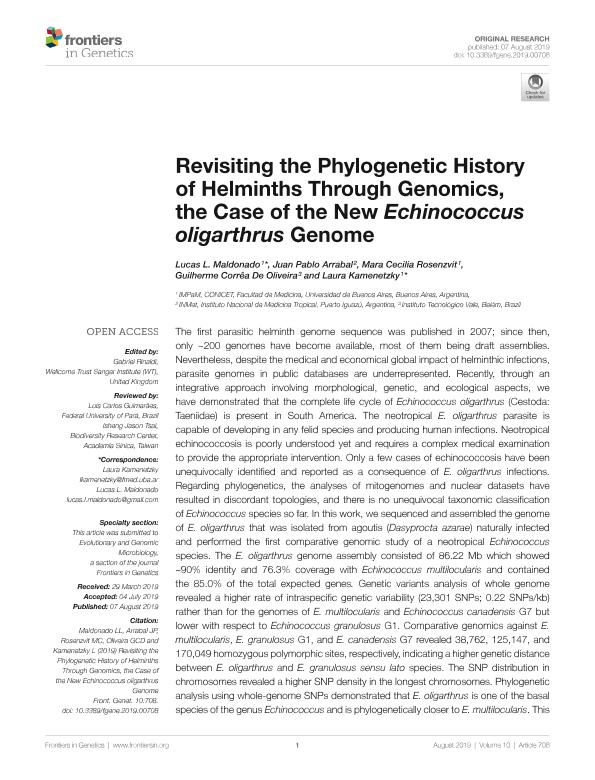Artículo
Revisiting the phylogenetic history of helminths through genomics, the case of the new echinococcus oligarthrus genome
Maldonado, Lucas Luciano ; Arrabal, Juan Pablo; Rosenzvit, Mara Cecilia
; Arrabal, Juan Pablo; Rosenzvit, Mara Cecilia ; De Oliveira, Guilherme Corrêa; Kamenetzky, Laura
; De Oliveira, Guilherme Corrêa; Kamenetzky, Laura
 ; Arrabal, Juan Pablo; Rosenzvit, Mara Cecilia
; Arrabal, Juan Pablo; Rosenzvit, Mara Cecilia ; De Oliveira, Guilherme Corrêa; Kamenetzky, Laura
; De Oliveira, Guilherme Corrêa; Kamenetzky, Laura
Fecha de publicación:
08/2019
Editorial:
Frontiers Media S.A.
Revista:
Frontiers in Genetics
ISSN:
1664-8021
Idioma:
Inglés
Tipo de recurso:
Artículo publicado
Clasificación temática:
Resumen
The first parasitic helminth genome sequence was published in 2007; since then, only ~200 genomes have become available, most of them being draft assemblies. Nevertheless, despite the medical and economical global impact of helminthic infections, parasite genomes in public databases are underrepresented. Recently, through an integrative approach involving morphological, genetic, and ecological aspects, we have demonstrated that the complete life cycle of Echinococcus oligarthrus (Cestoda: Taeniidae) is present in South America. The neotropical E. oligarthrus parasite is capable of developing in any felid species and producing human infections. Neotropical echinococcosis is poorly understood yet and requires a complex medical examination to provide the appropriate intervention. Only a few cases of echinococcosis have been unequivocally identified and reported as a consequence of E. oligarthrus infections. Regarding phylogenetics, the analyses of mitogenomes and nuclear datasets have resulted in discordant topologies, and there is no unequivocal taxonomic classification of Echinococcus species so far. In this work, we sequenced and assembled the genome of E. oligarthrus that was isolated from agoutis (Dasyprocta azarae) naturally infected and performed the first comparative genomic study of a neotropical Echinococcus species. The E. oligarthrus genome assembly consisted of 86.22 Mb which showed ~90% identity and 76.3% coverage with Echinococcus multilocularis and contained the 85.0% of the total expected genes. Genetic variants analysis of whole genome revealed a higher rate of intraspecific genetic variability (23,301 SNPs; 0.22 SNPs/kb) rather than for the genomes of E. multilocularis and Echinococcus canadensis G7 but lower with respect to Echinococcus granulosus G1. Comparative genomics against E. multilocularis, E. granulosus G1, and E. canadensis G7 revealed 38,762, 125,147, and 170,049 homozygous polymorphic sites, respectively, indicating a higher genetic distance between E. oligarthrus and E. granulosus sensu lato species. The SNP distribution in chromosomes revealed a higher SNP density in the longest chromosomes. Phylogenetic analysis using whole-genome SNPs demonstrated that E. oligarthrus is one of the basal species of the genus Echinococcus and is phylogenetically closer to E. multilocularis. This work sheds light on the Echinococcus phylogeny and settles the basis to study sylvatic Echinococcus species and their developmental evolutionary features.
Archivos asociados
Licencia
Identificadores
Colecciones
Articulos(IMPAM)
Articulos de INSTITUTO DE INVESTIGACIONES EN MICROBIOLOGIA Y PARASITOLOGIA MEDICA
Articulos de INSTITUTO DE INVESTIGACIONES EN MICROBIOLOGIA Y PARASITOLOGIA MEDICA
Citación
Maldonado, Lucas Luciano; Arrabal, Juan Pablo; Rosenzvit, Mara Cecilia; De Oliveira, Guilherme Corrêa; Kamenetzky, Laura; Revisiting the phylogenetic history of helminths through genomics, the case of the new echinococcus oligarthrus genome; Frontiers Media S.A.; Frontiers in Genetics; 10; JUL; 8-2019; 1-13
Compartir
Altmétricas



